Maureen Stapleton, who always could be believed when she said something, was true to her word.
After attending the memorial for Colleen Dewhurst in 1991, "Mo," as she was affectionately called by her friends, was heard to say, "I'm not coming to one of these things ever - except my own!" *
Yesterday, Ms. Stapleton, who died March 13 at age 80 of pulmonary disease [she was an inveterate smoker and drinker], was there at the Circle in the Square memorial tribute by family and peers to her legendary self and Tony and Drama Desk-winning stage and Oscar-winning screen career.
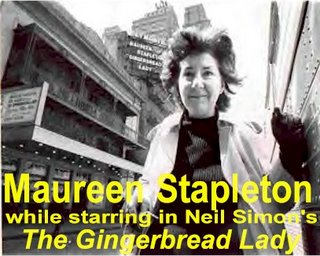 She was bigger than life in a video scrapbook of photos tracing her life from childhood in Upstate New York through numerous triumphs; and she was also heard singing.
She was bigger than life in a video scrapbook of photos tracing her life from childhood in Upstate New York through numerous triumphs; and she was also heard singing.
Ms. Stapleton, who made her Broadway debut in 1946 in The Playboy of the Western World and went on to win Tony Awards for her performances in The Rose Tattoo and The Gingerbread Lady, came alive in clips from film and TV roles and the vivid recollections of stars that worked with her.
In addition to her Tonys, Ms. Stapleton won an Oscar as best supporting actress for her work in the film Reds. Other starring roles included Orpheus Descending, The Glass Menagerie, Plaza Suite and The Little Foxes. Her film work included Queen of the Stardust Ballroom and Cocoon. She guest-starred during the Golden Age of 50s live TV dramas in, among many others, All the King's Men on the Kraft Television Theatre, For Whom the Bell Tolls on Playhouse 90 and on Studio One.
Among those present were Ms. Stapleton's son Danny Allentuck and daughter Katharine from her first marriage and the actress' brother Jack.
Recalling Ms. Stapleton's legendary phobias, such as fear of flying and elevators, were Allentuck and Broadway and Emmy-winning TV veteran Doris Roberts and Tony and Drama Desk winner Elizabeth Wilson**, who co-starred with Ms. Stapleton in 1972's short-lived The Secret Affairs of Mildred Wild; former co-star, DD winner and Tony nominee Bob Balaban; DD, Oscar and Emmy-winning actress and director Lee Grant, featured with Ms. Stapleton and a huge cast in 1949's Detective Story; Tony winner George Grizzard, who appeared with Ms. Stapleton twice [1965 and 1972]; and long-time friend, Tony and DD winner Frances Sternhagen.
Tony nominee Anne Jackson and multiple award-winner Eli Wallach also paid tribute. The Wallachs, a stand-up comedy team if ever there was one, can always be depended upon to be entertaining, and yesterday was no exception.
Mr. Wallach not only co-starred with Ms. Stapleton three times, including Tennessee Williams' acclaimed 1951 The Rose Tattoo, for which they won Tony Awards - in the Featured category!, but also was a life-long offstage friend.
Ms. Jackson described Ms. Stapleton as "a cross between a saint and the devil" and called her "a work of art who acted from the gut. "She is not gone," said Ms. Jackson. "She never will be. Maureen left a legacy."
Ms. Roberts read a remembrance from Tony-winning director Milton Katselas, who directed Ms. Stapleton and Harry Guardino in a short-lived 1966 Rose Tattoo revival [that featured a young Christopher Walken and Maria Tucci, who was Tony-nominated].
"Mo'''s reviews were not spectacular. In her brutally honest autobiography, A Hell of a Life [1995, with Jane Scovell], she comments that just as the curtain was about to go up the next night, one of the snippy sisters playing "child" asked if she'd read the reviews. She whispered no, and the girl told her "They said you were too old and too fat." Then the curtain went up. Do you wonder what happened to that kid when the curtain came down?
It will come as no surprise that Ms. Stapleton was every bit as pugnacious in life as she was onstage. Several spoke on how she hated injustices, and did what she could to rectify them. Ms. Grant spoke of Ms. Stapleton and Kim Stanley risking their careers by signing petitions supporting her when she was blacklisted.
Balaban spoke of how Ms. Stapleton nourished and watched over him when he was a struggling actor in 1968 making his Broadway debut in Plaza Suite; and the four a.m. call he received when she found out he wasn't so poor. "Why didn't you tell me you came from money?" she barked. His family owned theatres in Chicago and an uncle was head of Paramount.
Then there was the time "Mo" steeled herself for the ride up in the elevator at Balaban's building for a party...and how the elevator got stuck and Ms. Stapleton had to be hoisted up through the car's ceiling and stand on top until firemen came to the rescue. When she finally entered the apartment, she patted him on the face and said, "Next time, get something on the second floor."
Barbara Cook sang via recording ["There Was You" from The Fantasticks], later appearing live doing a moving rendition of Amanda McBroom's ballad "Ship in A Bottle." When the applause faded, Cook said, "That's the kind of song Mo would hate!" She segued into one that Ms. Stapleton loved, "Hard-hearted Hanna."
Recalling the only time Ms. Stapleton heard her in a club, she said. "I'd done some pop songs. Afterward, Maureen said, ëI'm not going to tell you you're good. You know you're good, but I don't want to hear all that s#^t!'"
She brought the house down again remembering some prim and proper ladies who lunch, decked out in finery including white gloves and pearl necklaces, who were admiring a huge framed painting that ran along a hotel corridor. "They were wondering what artist had done it and what it was supposed to be, when Maureen blurted, ëI'll tell you what it is. It's thirty-five feet of s#^!'"
Among notables in the audience were Alec Baldwin, Doris Belack [wife of producer/director/playwright Philip Rose], veteran music director and arranger Abba Bogin, Tony winner Zoe Caldwell, DD winner Joan Copeland, Marge Champion, Harvey Evans, Carol Kane [currently starring in Wicked], film producer Rick McKay [Broadway: The Golden Age, by the Legends Who Were There], two-time Oscar nominee Sylvia Miles; Tony-nominee Rosemary Murphy, famed New Yorker columnist Lillian Ross, Tony and DD winner Marian Seldes, Tony-nominee and DD winner Lois Smith, Tony nominee and DD Lifetime Achievement Award honoree Helen Stenborg [widow of Bernard Hughes], Betsy von Furstenberg [who co-starred with Ms. Stapleton in The Gingerbread Lady] and Tony nominee Walter Willison, who made his Broadway debut opposite Ms. Stapleton in 1970's short-lived Norman, Is That You? [which, if IBDB.com's records are correct, she played for two weeks while she was still in Plaza Suite].
There were other recollections of their friend "Mo" sent from such friends as Kaye Ballard, Diane Keaton, Tony winner Patricia Neal, Woody Allen and multiple Tony-winners Julie Harris, Ms. Caldwell and Mike Nichols.
Ballard, whose almost tell-all autobiography How I Lost 10 Pounds in 53 Years is just out in a new edition [Backstage Books], wrote of Ms. Stapleton and Ethel Merman visiting after a preview of Molly [1973], based on the character created on radio and TV by Gertrude Berg.
It was Ballard's first time with billing above the title. "I was a bit nervous," she said. "Neither were known for pulling any punches. When they entered, Ethel shouted, ëBallard! Where the hell's the john?' and Maureen said, very calmly, in a voice only heard in a baseball park, ëGet the f#^k out of this!'" The show closed two days shy of a month.
 In a 1981 letter, Lillian Hellman congratulated Ms. Stapleton on Hudson Valley Community College in her hometown of Troy naming their theatre in her honor. Then Ms. Hellman proposed that "Alongside the theatre...[that] will prove you are a better actress than Eleanor Duse, who was to my mind a very bad one, there be another place of worship set up as a tributeÖa small Champagne parlor."
In a 1981 letter, Lillian Hellman congratulated Ms. Stapleton on Hudson Valley Community College in her hometown of Troy naming their theatre in her honor. Then Ms. Hellman proposed that "Alongside the theatre...[that] will prove you are a better actress than Eleanor Duse, who was to my mind a very bad one, there be another place of worship set up as a tributeÖa small Champagne parlor."
In Ms. Stapleton's last Broadway appearance, as Birdie in the 1981 revival of The Little Foxes, all the attention was on Elizabeth Taylor as Regina Giddens. Though Taylor acquitted herself quite well, the play belonged to Ms. Stapleton. Her performance was wondrously poignant and heart wrenching. It netted her a Tony nomination.
Maureen Stapleton, winner of an Oscar, Tonys, Drama Desk, Grammy and an Emmy and a 1981 inductee into the Theatre Hall of Fame, made up her mind to be an actress at age eight. In her late teens, she was determined to escape her Troy roots for acting.
"The first time I informed my mother that I was going to be an actress," Ms. Stapleton wrote in her autobiography, "she said 'Okay, okay, be an actress.' She didn't get that I wasn't asking her permission, I was telling her what I was going to do. It was a declaration of independence."
Ms. Stapleton stated that no one encouraged her. "My ambition came from left field. There were no actors or performers in the family, no tradition of the theater, nothing to follow, just something to go after. No one had said, 'Yes, you've got it, baby, go after it.' I made up my mind all on my own."
She stated that she never wanted to do anything else. "I'm not sure there's anything else I could have done. I don't feel I had a choice. For a fat, struggling kid like me, the only way out was to be someone else."
For those who experienced Ms. Stapleton's memorable stage and screen performances, it's not such a surprise that the shy loneliness and poignancy she brought to her roles was rooted in the intense emotion of her childhood, especially her view of men based on her strict Irish Catholic upbringing and non-relationship with her alcoholic father.
"Mo" was awestruck with the Hollywood legends of her childhood movie-going--not to mention actors Barton MacLane and Joel McCrea. She was addicted to the fan magazines of that period.
Onstage and onscreen, Ms. Stapleton was always a masterful craftsperson, superb in what she did and how she seem to make it look so easy. In her personal life, as well-documented by her son and others at the memorial, she was a mess of phobias and paranoia, and a mass of contradictions.
In her autobiography, Ms. Stapleton's remembrance of Colleen Dewhurst is eloquent, funny and sad - a celebration of "a unique, warm, giving, and sloppy as hell human being and actress who allowed herself to die before her time." She reminisced about the loss of so many good and valued friends.
In those pages, between tales of her legendary neuroses and wonderful remembrances of a Who's Who of Theater, there're anecdotes about her relationship with Bud Brando [Marlon to the rest of us], George Abbott [with whom she had an intense affair and almost married], Tennessee Williams, Noel Coward, Sidney Lumet, Gary Cooper, Marilyn Monroe, Hellman, Montgomery Clift, the Jacksons, Taylor, Allen and "Sir Lord God," her fond name for Laurence Olivier.
Ms. Stapleton in a most direct and down to earth manner also imparted valuable information to the working actor and beginner and gives great insights into acting. Though she frequently made light of what is required of an actor ["Acting? I do a job. I get paid. I go home"], she devoted hours to her characterizations, no doubt a trait she inherited from her years at the Actors Studio.
Some of her comments: "I've been asked so damn many times about acting and how you do it and all that crap. I'm still at a loss as to how to describe it. Listen, acting is acting. Your task is to keep the audience awake and interested, and make no mistake, keeping them awake is numero uno. You get your skills going, the technical stuff like movement and voice projection - although with all the goddamn miking going on today, who the hell needs to project? - and after that, you have to center your energies."
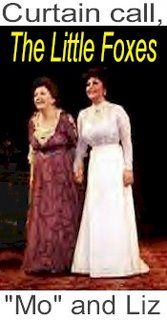 The part of acting Ms. Stapleton loved most was the challenge and opportunity to leave reality behind and become someone completely different. "But," she wrote, "difficulties do arise. Acting can be all-consuming, but you can't allow yourself to be consumed. You shouldn't continue acting when the curtain comes down. Sounds easy, but it's hard to extricate yourself from inside that person after being in character for an evening.
The part of acting Ms. Stapleton loved most was the challenge and opportunity to leave reality behind and become someone completely different. "But," she wrote, "difficulties do arise. Acting can be all-consuming, but you can't allow yourself to be consumed. You shouldn't continue acting when the curtain comes down. Sounds easy, but it's hard to extricate yourself from inside that person after being in character for an evening.
"As I grew older and more experienced," she continued, "I tried to close the door a bit tighter and not drag my impersonation into my real life. Coming back to reality is tough, though, and when you're in a long-running play, it becomes even tougher."
Keeping fresh was another important task, which she noted wasn't so easy. "You have to, though, because each night is a different audience and you owe them your best. You can't just let down one night and say, 'Gee, too bad you guys didn't catch me yesterday.' You have to be in peak condition. You've got to get lots of sleep and you've got to keep the level of your performance up."
"Your aim," she went on, "is to be the character. You can't be outside yourself and looking in. You plunge in. Your full concentration is on the problems of whomever you're pretending to be. And you have to pretend anew at each performance."
The key word for Ms. Stapleton was "pretend." She revealed that she was never a big fan of reality. "Give me magic any day. Magic is what you get in acting. I love the pretense."
When Ms. Stapleton came to New York to study acting, she reported, "No one saw a Sarah Bernhardt aching to break out."
She made her debut in 1935 in a school production as a gypsy. That was "probably the last time I portrayed anyone under fifty. I was cast as an older woman. I was heavy, and 'heavy' translates 'old' on the stage whether you're twelve or twenty. So I played old dames - mothers, grandmothers, maiden aunts, stuff like that."
At the memorial, Grizzard who played Tom Wingfield in the 1965 revival of The Glass Menagerie, noted Ms. Stapleton played his mother, Amanda, "which made her three years old when I was born." He was born in 1928; she in 1925."
No one, she advised, should go into acting to make money. "But," she countered, "you have to survive, and good hard cash makes it possible to survive in style. The more money I have, the finer artist I feel I am. While I think I was an okay actress, it's too damn bad I never got really rich."
Acting, noted Miss Stapleton, is "a mixed bag of pleasure and pain. If you had a brain in your head, you'd never chose to do it, but wanting to act isn't a question of intelligence. It's answering a need. I answered the call and it's too damn late to hang up. Acting is my job, my work, and the one area of my life in which I'm totally secure."
However, she pointed out that acting is not like other professions. "If you're a great plumber, doctor or seamstress, whatever the hell, people will beat a path to your door. You can be a great actor and the best you can hope for is to get a job for a while. Your own 'worth' doesn't necessarily come into the picture."
She added that no matter what job you have, you've got to accept the fact that you're going to be spending most of your life out of work. "If this crap weren't discouraging enough," she stated, "you have to sell yourself, too, over and over."
When you are working, she advised, "You have to be totally focused when you're on stage. There have been times when my concentration was challenged. Loud noises kill me, and yet I'm not especially thrown by the sounds of an audience like coughing, sneezing or talking."
Do you wonder what type of response audience members would get from "Mo" if their cell phones had gone off during one of her performances. Thankfully, we'll never know.
Ms. Stapleton did find applause satisfying "but whenever I start to get carried away, I remember Adlai Stevenson's reply when, while running for President, he was asked ëWhat's it like to hear all that applause? What's it like to know that people love you that much?' He answered, ëIt's fine if you don't inhale.'"
She found no shortage of good actors, "but what there isn't as much of is the kind of integrity and kindness personified by people like Katharine Cornell and [director] Guthrie McClintic. I learned theatrical behavior from them. Marlon Brando was a member of the Cornell troupe, and she may have been the one person in the theater he really respected. Probably because she may have been the only woman he'd ever met who didn't try to get in his pants."
It has often been written that Ms. Stapleton was best playing vulnerable heroines, but some of her best performances are playing pugnacious, profane women.
One reminisce that wasn't brought up yesterday was Ms. Stapleton's reply to a reporter when he asked, "How does it feel to be recognized as one of the greatest actresses in the world?" She replied, "Not nearly as exciting as it would be if I were acknowledged as one of the greatest lays in the world."
Ms. Stapleton's often-uttered goodbyes ended with her saying, "Did I forget to tell you that I love you?" No, you didn't, "Mo." And the feeling is mutual.
* At the memorial for Ms. Dewhurst, "Mo" recalled the Tony Awards when she and Ms. Dewhurst were nominated ["Mo" for Plaza Suite; Ms. Dewhurst for More Stately Mansions]. Declared "Mo": "And we both lost," pointing to Zoe Caldwell, "to that Australian c#^t." You could hear a pin drop as eyebrows were raised. When Ms. Caldwell practically hit the floor laughing, there was some nervous laughter from the audience. Many felt it was an occasion where "Mo" crossed the line. In the next day's New York Times, a critic agreed. Ms. Stapleton was criticized for being "inappropriate" and she swore she'd never attend another memorial except her own.
** Ms. Wilson was also Ms. Stapleton's understudy in Plaza Suite.
For extensive stage and screen credits of Maureen Stapleton, visit: IBDb.com - Internet Broadway Database; and IMDb.com - Internet Movie Database.
[I had the pleasure of knowing Ms. Stapleton during my tenure with MCA/ Universal Pictures and promoting her performance in 1970's Airport, for which she received an Oscar nomination for her poignant portrayal of long suffering wife Inez Guerrero (opposite Van Heflin). When she came to the New York premiere at the Cinerama, once the Strand and even later the Warner, she bounced in as the lights were about to go down and was being ushered to her seat.
"No, I want to sit in the balcony so I can smoke!" she said. When told there was no balcony, she replied, "Yes, there is. I've sat up there!"
"But," she was informed, "now it's a multiplex." "A what?" she asked in wonderment. I explained the balcony was now a separate theatre. As we started to her seat, she blurted, "Honey, get me a drink!" and I asked if she wanted a large or small Coca-Cola. "I want more than a Coca-Cola!" But all she got was a Coke.
Afterward, as I met up with her and she received acclades from media, industry execs and Burt Lancaster and Dean Martin, she couldn't understand what all the "fuss" was about.
That led to a discussion at a later luncheon. Ms. Stapleton said onstage, "you get instant audience reaction"; but when you work in film and TV, "it's stop, wait, action, cut and then the edit. There's no instant gratification." ]
Reminder: Cy Feuer, Tony-winning Broadway producer [Guys and Dolls, How To Succeed..., many others], director, film producer [Cabaret, ACL], film score composer and long-time president and chairman of the League of American Theatres and Producers, will be remembered at a memorial on Thursday at 1 P.M. at the Lunt-Fontanne Theatre.
[Photos: Maureen Stapleton at the Oscars, PHIL ROACH/Globe; The Little Foxes, MARTHA SWOPE]
--------




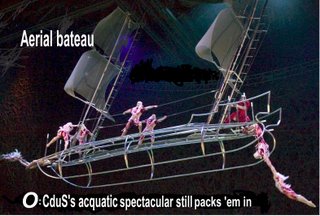

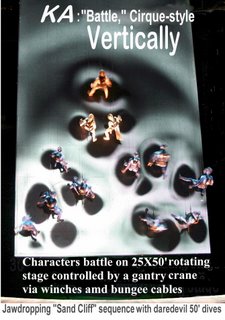
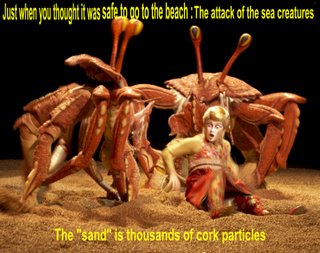
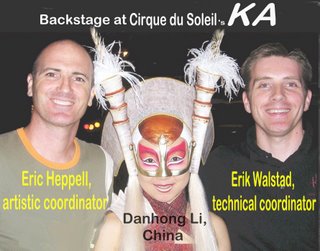
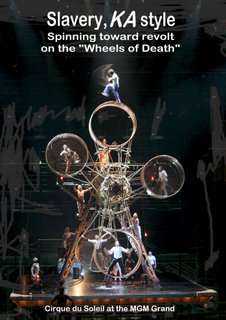
 While this reinvention was taking place, Vegas was also undergoing another transformation. Since the opening of Caesar's in 1960, The Strip resorts have become known not only for imploding the old for the megacomplexes but also for spectacular entertainment.
While this reinvention was taking place, Vegas was also undergoing another transformation. Since the opening of Caesar's in 1960, The Strip resorts have become known not only for imploding the old for the megacomplexes but also for spectacular entertainment.



